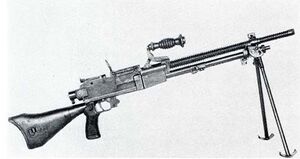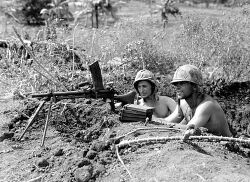Engineering:Type 96 light machine gun
| Type 96 light machine gun | |
|---|---|
 Type 96 light machine gun (without magazine) | |
| Type | Light machine gun |
| Place of origin | Empire of Japan |
| Service history | |
| In service | 1936–1945 |
| Used by | See Users |
| Wars | Second Sino-Japanese War Soviet–Japanese border conflicts World War II Indonesian National Revolution Chinese Civil War Korean War First Indochina War Vietnam War |
| Production history | |
| Designer | Kijiro Nambu |
| Designed | 1936 |
| Unit cost | 1,125 yen ($263 USD) in December 1941[1][2] |
| Produced | 1936–1943 |
| No. built | 41,000 |
| Specifications | |
| Mass | 9 kg (20 lb) |
| Length | 1,070 mm (42 in) |
| Barrel length | 550 mm (22 in) |
| Cartridge | 6.5×50mm Arisaka |
| Action | Gas-operated |
| Rate of fire | 550 rounds/min |
| Muzzle velocity | 735 m/s (2,410 ft/s) |
| Effective firing range | 800 m (870 yd) |
| Maximum firing range | 3,500 m (3,800 yd) (6.5×50mm Arisaka) |
| Feed system | 30 round detachable box magazine |
The Type 96 light machine gun (九六式軽機関銃 Kyūroku-shiki Kei-kikanjū) was a light machine gun used by the Imperial Japanese Army in the interwar period and in World War II.[3] It was first introduced in 1936, and fires the 6.5×50mm Arisaka from 30-round top-mounted magazines. A combination of unimpressive ballistic performance and a lack of reliability caused the Imperial Japanese Army to try to replace the Type 96 with the Type 99 light machine gun, though both saw major usage until the end of the war.
History and development

Combat experience in the Manchurian Incident of 1931 and subsequent actions in Manchuria and northern China reaffirmed to the Japanese army the utility of machine guns in providing covering fire for advancing infantry.[4] The earlier Type 11 light machine gun was a lightweight machine gun, which could be easily transportable by an infantry squad into combat. However, the open hopper design of the Type 11 allowed dust and grit to enter into the gun, which was liable to jam in muddy or dirty conditions due to issues with poor dimensional tolerances.[5] This gave the weapon a bad reputation with Japanese troops, and led to calls for its redesign.[6] The Army's Kokura Arsenal tested the Czechoslovak ZB vz. 26 machine gun, samples of which had been captured from the National Revolutionary Army of the Republic of China, and (after borrowing certain elements) issued a new design, designated the Type 96 light machine gun, in 1936.[7] The gun was produced at Kokura, Nagoya Arsenal and Mukden between 1936 and 1943, with a total production run of about 41,000.[8]
According to Rottman, the Type 96 was a slightly modified copy of the ZB vz.26 despite claims to the contrary,[9] while US military manuals note that the gun combined the features of both the Hotchkiss machine gun and the ZB vs. 26.[10] Ness notes that the Type 96 featured a unique bolt lock system designed by Kijiro Nambu.[11]
Design


The Type 96 light machine gun was almost a complete reworking of the Type 11, combining the features of the Hotchkiss with some of the ZB vz. 26.[12][10] As with the Type 11, it continued to use the same 6.5×50mm Arisaka cartridges as the Type 38 rifle infantry rifle,[13] although the adoption of the more powerful 7.7×58mm Arisaka rimless round for the Type 99 rifle soon created a demand for a new light machine gun capable of firing the same ammunition, the Type 99 light machine gun.[14] Due to their visual resemblance to the British Bren light machine gun they are often mistakenly regarded as clones.[15]
The major differences from the Type 11 were the top-mounted curved detachable box replacing the problematic ammunition hopper with an overhead magazine and the removal of the receiver-mounted oiler (though cartridges needed to be lubricated before they were loaded into the magazines), the latter made possible the incorporation of a quick-change barrel to avoid overheating; the Type 96 also features a unique Nambu-designed bolt lock, in the form of a square frame that moves up and down to lock and unlock the barrel.[16] The Type 96 had a blade front sight and a leaf rear sight, with graduations from 200 to 1,500 meters, with windage adjustment. A 2.5X telescopic sight with a 10 degree field of view could be attached at the right side of the gun.[13]
The Type 96 also had a folding bipod attached to the gas block, and could be fitted with the standard infantry Type 30 bayonet, which could be attached to the gas block below the barrel,[17] making it, alongside the later Type 99 the only machine gun used in the Second World War that a bayonet could be attached to,[18] despite the fact that the weapon weight of 9 kg (20 lb) made it awkward to handle in hand-to-hand combat.[19] The gun had no select-fire capability.[20]
The Type 96 was somewhat more reliable than the Type 11, but it still required the use of lubricated ammunition to avoid jams.[12] In practice, this tended to worsen the problem instead, as the oiled cartridges tended to become coated with dust and sand.[19] This feature and its inherent faults were dropped with the introduction of the Type 99 light machine gun.[20] Like the Type 11, the gun doesn't handle standard 6.5×50mm Arisaka rounds without malfunctions, requiring the use of special ammunition (marked with a circled "G" on the cartons) to ensure proper extraction of spent cases.[19][21]
Parts were usually non-interchangeable, each gun being hand-fitted and manufacturers introducing minor changes to their designs, such as flash suppressor, cooling fins, and ejection port covers, without any regard for standardization; an issue that also plagued its successor, the Type 99.[22]
Combat record

The Type 96 came into active service in 1936 and was intended to replace the older Type 11; however the Type 11 had already been produced in large quantities, and both weapons remained in service until the end of the war.[23] The Type 96 handled well and could be easily fired from the hip, but it was sensitive to dirt, dust, and sand, requiring it to be always kept clean and oiled.[24] While the gun's light weight and mobility proved to be useful in jungle warfare, the 6.5 mm caliber wasn't entirely suitable for combat situations.[25] It was supplanted by the more reliable Type 99 light machine gun, which fired a larger 7.7 mm round and had greater stopping power.[26][27]
According to US military manuals, reports of Japanese soldiers making use of Thompson submachine guns may have originated from the fact that the Type 96 could be hip fired.[28]
After World War II, it was used by Indonesian forces during the Indonesian National Revolution against Dutch forces[29] notably during the attack on Jogjakarta 1949. It was used by the Viet Minh and the North Vietnamese forces during the First and Second Indochina Wars.[30]
Users
 Republic of China
Republic of China People's Republic of China[31]
People's Republic of China[31] Indonesia[29]
Indonesia[29] Empire of Japan[32]
Empire of Japan[32] North Korea[33]
North Korea[33] Thailand[34]
Thailand[34] Vietnam[30]
Vietnam[30]
Notes
- ↑ "兵器臨時価格表(甲)昭和16年12月 Military catalogue of the Japanese military Showa 16" (in ja). Ministry of the Army. p. 7. https://www.jacar.archives.go.jp/aj/meta/listPhoto?LANG=default&BID=F2014020316163636075&ID=M2014020316163636079&REFCODE=C14010888900.
- ↑ Banking and Monetary Statistics, 1914-1941, Part I, p. 673
- ↑ Bishop 1998, pp. 238–239.
- ↑ Mayer 1984, p. 53.
- ↑ Rottman, Gordon L. (2005). Japanese Army in World War II - Conquest of the Pacific 1941-42. Oxford, England: Osprey Publishing. p. 46. ISBN 1841767891. https://archive.org/details/japanesearmyworl00rott_833.
- ↑ Mayer 1984, p. 55.
- ↑ Ness 2014, pp. 44−45.
- ↑ "Ground Guns". http://www.japaneseweapons.net/kikanjyu/shurui/english01.htm.
- ↑ Rottman 2013, p. 74.
- ↑ 10.0 10.1 War Department General Staff 1943, p. 96.
- ↑ Ness 2014, p. 44,51.
- ↑ 12.0 12.1 Ness 2014, pp. 50−51.
- ↑ 13.0 13.1 US Department of War (1994). Handbook on Japanese Military Forces, TM-E 30-480 (1945) (reprint ed.). Louisiana State University Press. ISBN 0-8071-2013-8. http://www.ibiblio.org/hyperwar/Japan/IJA/HB/HB-9.html#III.
- ↑ Ness 2014, p. 45.
- ↑ McCollum, Ian (September 3, 2015). "RIA: Nambu Type 96 & Type 99 LMGs". https://www.forgottenweapons.com/ria-nambu-type-96-type-99-lmgs/.
- ↑ Ness 2014, pp. 44, 51.
- ↑ War Department General Staff 1943, pp. 96, 100, 104.
- ↑ Bishop 1998, pp. 238−239.
- ↑ 19.0 19.1 19.2 Rottman 2013, p. 73.
- ↑ 20.0 20.1 Ness 2014, p. 51.
- ↑ War Department General Staff 1943, p. 103.
- ↑ Ness 2014, p. 45−46.
- ↑ Bishop 1998, p. 238.
- ↑ War Department General Staff 1943, pp. 96, 103.
- ↑ War Department General Staff 1943, p. 2.
- ↑ Ness 2014, pp. 45, 51.
- ↑ Adams 2021, p. 24.
- ↑ War Department 1942, p. 96.
- ↑ 29.0 29.1 Bloomfield, Lincoln P.; Leiss, Amelia Catherine (30 June 1967). The Control of local conflict : a design study on arms control and limited war in the developing areas. 3. Massachusetts Institute of Technology. Center for International Studies. p. 92. https://apps.dtic.mil/sti/pdfs/ADA324492.pdf#page=97.
- ↑ 30.0 30.1 Ezell, Edward Clinton (1988). Personal firepower. The Illustrated history of the Vietnam War 15. Bantam Books. pp. 48-49. ISBN 9780553345490. OCLC 1036801376. https://archive.org/details/personalfirepowe00ezel.
- ↑ Jowett, Philip S. (1997). Chinese Civil War Armies 1911-49. Men at Arms 306. Osprey Publishing. p. 47. ISBN 9781855326651.
- ↑ Machine Guns: An Illustrated History of Their Impact by James H. Willbanks, page 104.
- ↑ Kinard, Jeff (2010). "Machine guns". The Encyclopedia of the Korean War: A Political, Social, and Military History. 1. A-L (2nd ed.). ABC-CLIO. p. 535. ISBN 978-1-85109-849-1. https://books.google.com/books?id=1ZNxDwAAQBAJ&pg=RA1-PA535. Retrieved 2018-11-15.
- ↑ "ปกบ. แบบ 83". 6 March 2020. http://sanpawut.police.go.th/New%20folder/gun/b%2083%20japan%20%206.5%20mm.html.
References
- Adams, Gregg (28 October 2021) (in en). Japanese Soldier vs US Soldier: New Guinea 1942–44. Bloomsbury Publishing. ISBN 978-1-4728-4414-9. https://books.google.com/books?id=tTo9EAAAQBAJ.
- Bishop, Chris, ed (1998). The Encyclopedia of Weapons of World War II (1st ed.). Barnes & Noble Books. ISBN 978-0760710227. https://archive.org/details/tractors-29177010-Encyclopedia-of-Weapons-of-World-War-II/mode/2up. Retrieved 5 October 2024.
- Mayer, S. L., ed (1984). The Rise and Fall of Imperial Japan. The Military Press. ISBN 0-517-42313-8. https://archive.org/details/risefallofimperi0000unse.
- Ness, Leland (2014) (in en). Rikugun: Volume 2 - Weapons of the Imperial Japanese Army & Navy Ground Forces. Helion. ISBN 978-1-912174-58-4. https://books.google.com/books?id=bYQwDwAAQBAJ.
- Popenker, Maxim (2008). Machine Gun: The Development of the Machine Gun from the Nineteenth Century to the Present Day. Crowood. ISBN 978-1-84797-030-5. https://archive.org/details/machinegundevelo0000pope.
- Rottman, Gordon L. (2005). Japanese Infantryman 1937–1945. Osprey Publishing. ISBN 1-84176-818-9.
- Rottman, Gordon L. (2013) (in en). The Big Book of Gun Trivia: Everything you want to know, don't want to know, and don't know you need to know. Bloomsbury Publishing. ISBN 978-1-78200-949-8. https://books.google.com/books?id=qEnDCwAAQBAJ.
- "Banking and Monetary Statistics, 1914-1941, Part I". Board of Governors of the Federal Reserve System (U.S.). January 1943. https://fraser.stlouisfed.org/title/38#6408.
- War Department, United States (1942) (in en). War Department Technical Manual. Washington, DC: U.S. Government Printing Office. https://books.google.com/books?id=CMQIAQAAIAAJ&dq=type+96+light+machine+gun+hotchkiss&pg=PA95. Retrieved 4 October 2024.
- War Department General Staff, United States (1943) (in en). Japanese Infantry Weapons. U.S. Government Printing Office. https://books.google.com/books?id=SiJmBMaY1NAC. Retrieved 5 October 2024.
External links
Template:Japanese WWII infantry weapons
 |
